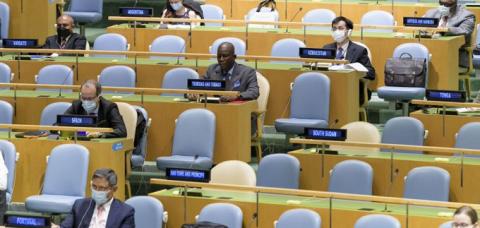
MULLAHS TORTURE AND EXECUTE WHILE UN DITHERS
While international leaders from around the world are making lofty speeches at the UN General Assembly in New York, during their ‘virtual’ annual conference this week, the Iranian regime has plumbed the depths of depravity by torturing and executing young political prisoners who were arrested during the nationwide uprisings in 2018 and 2019. On 12th September they hanged 26-year-old Navid Afkari, a champion wrestler and a celebrity in Iran. He had been detained along with his two brothers for participating in street protests in the city of Shiraz in 2018. Afkari was brutally tortured for 50 days then forced to make a false, televised confession. His burial was restricted to only half a dozen close family members and heavily policed to prevent further mass demonstrations from Iranians outraged by his execution. Seventeen Nobel laureates signed a statement condemning Navid Afkari’s execution. Now, many other political prisoners, tortured into making confessions, have been transferred to death row to await execution.
Resistance units inside Iran have uncovered the scandalous extent of torture and human rights abuse directed mainly at political prisoners and particularly at the thousands of young people detained during the nationwide uprising across Iran last November. The Islamic Revolutionary Guards Corps (IRGC), the theocratic regime’s Gestapo, has utilized its Intelligence Division to set up a network of temporary and secret torture centers across Iran to deal with the huge number of arrested protesters. In Shiraz, the city where Navid Afkari was brutalized and executed, the secret torture center has been identified in the Ebrat building.
Over 12,000 political prisoners, many of whom were children or teenagers under the age of 18, who were arrested following the November uprising, were taken to Ebrat and other secret torture centers across Iran for brutal beatings, agonizing electric shock torture, mock executions and whippings, to force them to make false confessions, after which they were transferred to prisons such as Gohardasht, Evin and Greater Tehran (Fashafuyeh) for detention and possible execution. Secret torture centers have been identified at Shahriar Security Police Center and Gisha Security Police base, amongst a long list of others. Many prisoners who were severely wounded by torture, by having their fingernails pulled out, or bones broken, were denied medical attention after their wounds became infected. Dozens who were wounded by gunshots during the protests, when the IRGC and security forces fired live ammunition into the crowds, killing 1500 and wounding thousands, were dragged from their hospital beds by the security forces. They were taken to the network of secret torture centers where they were tied, blindfolded and assaulted for days on end. Some died under torture.
These are depraved crimes against humanity of the worst kind. It is incredible that medieval tortures and executions are continuing now, even as leaders of the international community participate in the UN General Assembly in New York, making noble speeches about human rights. It is a scandalous indictment of the international community’s failure to hold the Iranian regime to account for these crimes and indeed for the 1988 massacre of over 30,000 political prisoners, one of the worst atrocities since the end of World War II. It is thought-provoking that the UN recently sent an independent mission of investigation to Venezuela, resulting in a harsh and condemnatory report accusing the Maduro regime of human rights abuse in that country. While that action was commendable, it is bewildering that no such similar action has been directed at the Iranian regime, where the abuse of human rights is much, much worse than in Venezuela.
At a time when both Amnesty International and the UN High Commissioner for Human Rights have furnished the UN Secretary General with detailed reports on the abuse of human rights ongoing in Iran, urgent action needs to be taken. The UN must instruct an independent mission of investigation to visit political prisoners in Iran and demand their immediate release. They must urge individual member states of the UN, particularly from European countries, to instruct their ambassadors in Tehran to visit political prisoners and to call for an end to torture and execution. The world cannot stand idly by and watch this horror unfold.
Twenty-one human rights groups have now issued a joint-appeal to the United Nations to launch an investigation into the 1988 massacre of political prisoners in Iran. The massacre, which led to the execution of more than 30,000 political prisoners, primarily members of the opposition People's Mojahedin Organization of Iran (PMOI/MEK), has never been investigated and the perpetrators have never been held to account. Many of the key executioners from 1988 are now in positions of power in the theocratic regime. Key among them is Ebrahim Raisi, the regime’s current judiciary chief. In 1988, he was Tehran’s Deputy Prosecutor and a key member of Tehran’s “Death Commission,” a group of regime officials who carried out minutes-long trials for the prisoners being sent to the gallows. Alireza Avaie, a member of the Death Committee in Khuzestan, is today Justice Minister in President Hassan Rouhani’s government. His two predecessors, who held office in the previous eight years, Mustafa Pour-Mohammadi and Morteza Bakhtiari, were also members of the Death Commissions.
Surely this is a wake-up call for the UN. The time for fine words is long past and the time for action has arrived. The UN must stop dithering. There must be no impunity for those past and present crimes. The guilty must be indicted for crimes against humanity and brought before the international criminal courts. As the UN General Assembly continues in New York, the world is watching.



